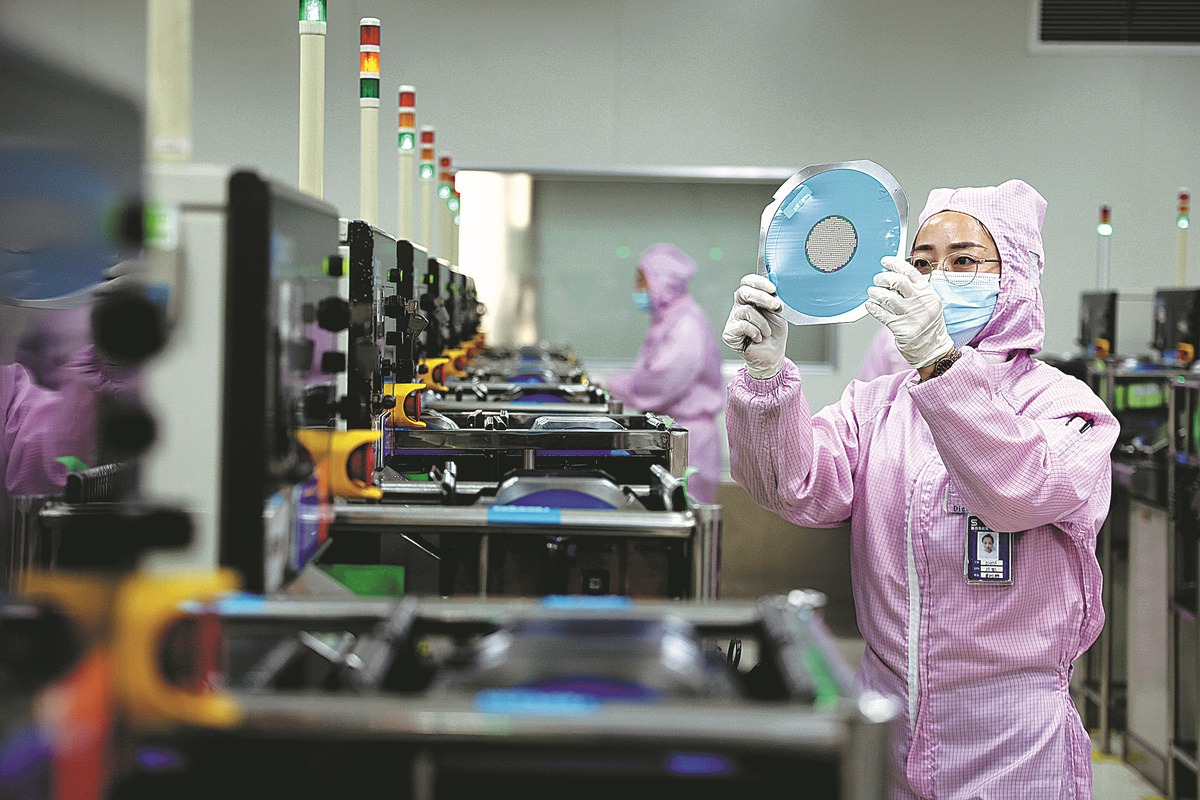头条英文播报 | Nation aims for breakthroughs in chip sector
A staff member works on the production line of a semiconductor manufacturer in Binzhou, Shandong province. [Photo by Chu Baorui/For China Daily]
Development of high-end products to speed up amid fierce global competition
The United States' and the European Union's multibillion-dollar plans to support their semiconductor industries will fuel global competition in the strategically important sector, and China needs to double down to achieve breakthroughs in core chipmaking technologies, experts said on Thursday.
The comments came after the European Commission announced a new European Chips Act earlier this week that involves more than 43 billion euros ($49 billion) in public and private funding, with a goal of doubling the EU's share of global chip production from 9 percent to 20 percent by 2030.
Last week, the US House of Representatives also approved $52 billion of federal funding for the US semiconductor industry.
Bai Ming, deputy director of international market research at the Chinese Academy of International Trade and Economic Cooperation, said the plans from the US and EU highlight the importance of chips to economic recovery amid the COVID-19 pandemic and to future economic growth.
"Competition in the global chip sector has reached a new high," Bai said, adding that China has rolled out a string of policies, including tax reductions and funding support, to accelerate the development of its semiconductor sector.
"I believe such policies will evolve and be further strengthened," Bai said, adding that more efforts will be made to encourage Chinese companies to achieve breakthroughs in core chip technologies.
The outline of the 14th Five-Year Plan (2021-25) for National Economic and Social Development and the Long-Range Objectives Through the Year 2035, for instance, said China will speed up the development of high-end chips.
The Ministry of Industry and Information Technology, China's top industry regulator, said that one of its top priorities during the 14th Five-Year Plan period is to advance the modernization of industrial chains and to encourage companies to overcome crucial technical bottlenecks such as in the field of high-end semiconductor equipment.
Local governments in areas such as Shanghai, Tianjin and Guangdong and Zhejiang provinces are also moving fast, identifying integrated circuits as one of their key industries during the 14th Five-Year Plan period.
Roger Sheng, vice-president of research at US market research company Gartner, said that as the world's largest chip market, China's semiconductor industry has made progress in recent years.
In 2021, the sales revenue of China's integrated circuit industry exceeded 1 trillion yuan ($157.3 billion) for the first time, with year-on-year growth of 18 percent, according to estimates by the China Semiconductor Industry Association.
In comparison, global semiconductor revenue grew at a compound annual growth rate of 25.6 percent to $552.9 billion last year.
But there is still a big technical gap between Chinese chipmakers and their foreign peers, especially in high-end chipmaking equipment and fundamental chip materials, Sheng said. China, for instance, relies heavily on imports for lithography machines that play a crucial role in chip production.
To achieve breakthroughs in these areas, money is not enough. "Talent and time are the keys," Sheng added.
Fang Xingdong, an independent expert who has been following the semiconductor industry for more than two decades, said the sector in China now faces increasingly fierce competition, as well as technological restrictions from the US government.
The New York Times described the legislation that includes the $52 billion chip plan, if enacted, as the most expansive attempt yet by the US to take on China. Washington has also restricted dozens of Chinese companies' access to US technologies including semiconductor equipment and software.
"Within such a context, we have to beef up support and better leverage public and private resources to support homegrown semiconductor innovation," Fang said.
Find more audio news on the China Daily app.
记者:马思
播报:Corrie Knight
音频编辑:万月英
【背景阅读】
欧盟公布《芯片法案》
人民日报布鲁塞尔2月9日电 欧盟委员会2022年2月8日公布《芯片法案》,希望通过增加投资、加强研发,扩大欧盟芯片产能在全球市场占比。
根据该法案,欧盟拟动用超过430亿欧元的公共和私有资金,使欧盟到2030年能够生产全球20%的芯片。目前欧盟所产芯片仅占全球份额的不到10%。法案需得到欧盟各成员国和欧洲议会批准才能正式生效。
《芯片法案》包括一项“欧盟芯片倡议”,将汇集欧盟及其成员国和第三国的相关资源,并建立确保供应安全的芯片基金。该法案条款还包括监测欧盟产芯片出口机制,可在危机时期控制芯片出口;强调加强欧盟在芯片领域的研发能力,允许国家支持建设芯片生产设施,支持小型初创企业。
欧盟委员会主席冯德莱恩当天发表讲话说,在短期内,此举有助预判并避免芯片供应链中断,增强对未来危机的抵御能力;从长远来看,《芯片法案》应能实现“从实验室到晶圆厂”的知识转移,并将欧盟定位为“创新下游市场的技术领导者”。
2021年,欧洲企业备受全球芯片短缺困扰,汽车制造业更是成为重灾区,一些汽车工厂被迫数次停产。欧盟希望通过加大对芯片产业的投资来降低对外部市场的依赖,但欧盟竞争事务专员维斯特格表示,欧盟距离实现芯片自给还有很长的路要走。(来源:人民日报)
美商务部呼吁加大芯片生产投资
据美联社报道,美国商务部2022年1月25日公布的一项调查结果显示,全球半导体供应链仍然脆弱,芯片供应短缺状况仍将持续至少6个月。美国商务部呼吁国会尽快通过立法加大美国国内芯片生产。
美国商务部在针对全球半导体供应链主要企业的调查报告中称,2021年芯片需求较2019年增长了17%。美国电脑芯片供应量已降至令人担忧的低水平,增加了工厂倒闭的可能性。“芯片供需存在严重、持续的错配,受访者认为这个问题在未来六个月内不会消失。”
美国商务部还表示,汽车制造商和医疗设备制造商使用的一些芯片价格异常高。该部门将“在未来几周内让业界参与解决特定环节的问题”。芯片短缺还扰乱了汽车生产,推高了汽车价格。
美国政府援引这一结果,呼吁国会通过立法,为其国内芯片生产提供520亿美元。美国商务部长雷蒙多在一份声明中称:“芯片供应链仍然脆弱,国会必须尽快通过芯片融资,随着需求飙升和现有制造设施的充分利用,很明显从长远来看解决这场危机的唯一办法就是重建国内制造能力。”
美国商务部2021年9月向全球半导体供应链主要企业发出通知,要求它们在45天之内向美方提供库存、产能、销售等信息,以确定全球半导体供应瓶颈状况。雷蒙多在11月曾表示,她已经“与供应链上的所有首席执行官,包括三星、台积电和SK集团等进行了交谈,所有的首席执行官都保证将提交可靠和完整的数据流”。
调查结果显示,受访企业认为半导体产业的主要供应瓶颈在于芯片工厂产能不足,其他瓶颈包括缺少半导体原材料、电子组装部件等。(来源:经济参考报)
责任编辑:钱耐安






